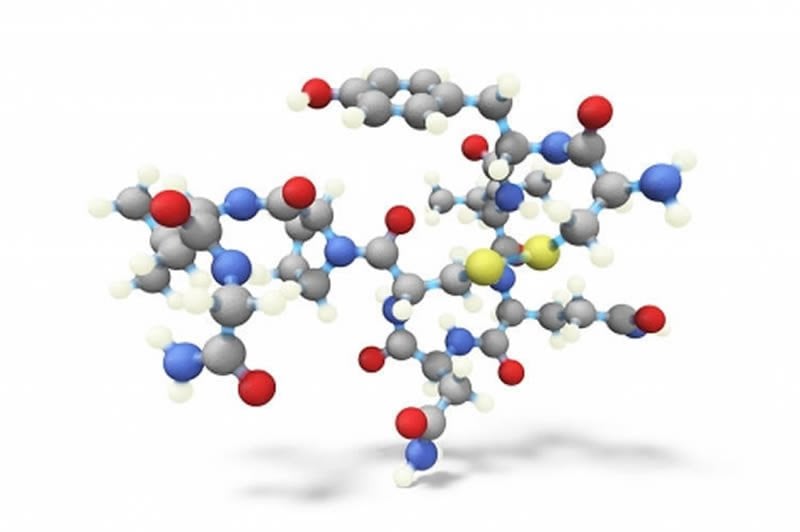Summary: Administering oxytocin via intravenous and nasal methods reduces regional blood flow to the amygdala.
Source: King’s College London
Oxytocin is known for its role in childbirth and breastfeeding and it has also been shown to have a wider application in the development and regulation of social behaviour in many species. There has been increasing interest in its potential use to help people overcome social difficulties as this can be one of the most difficult symptoms to treat in many psychiatric conditions such as schizophrenia, autism, anxiety and depression.
Research into the use of oxytocin almost always uses nasal spray application but little is known about how well this method delivers the required dose and reaches different areas of the brain.
Published in Nature Communications, the study is the first to compare different routes and administrations of synthetic oxytocin in terms of how they affect regional blood flow in the human brain, a surrogate measure of neuronal activation, as measured using fMRI scans.
Researchers compared three different methods in a sample of 17 male participants: injection of oxytocin into the blood; administration of oxytocin with a standard nasal spray; and administration with a nebuliser. The nebuliser, a special nasal delivery device which administered a fine spray of oxytocin in a pulsatile fashion, was investigated as it is thought it can better reach important parts of the nasal cavity.
The results showed that, compared to when no oxytocin is delivered, both the intravenous and the nasal route of administering oxytocin reduced regional blood flow to the amygdala which is a key brain area involved in processing of social information, emotion and social anxiety.
Researchers also showed that the nasal route targeted other specific brain areas and that the patterns of regional blood flow differed depending on whether oxytocin was delivered through a standard spray or the nebuliser.
Senior author, Yannis Paloyelis from the Institute of Psychiatry, Psychology & Neuroscience (IoPPN) King’s College London said: ‘Our results show that a one-size-fits-all approach to administrating oxytocin is not the best approach and, to a certain extent, it may be possible to target where in the brain it takes effect.

‘This has important implications for the potential application of oxytocin to patients as it suggests that, for some disorders, one route or mode of administration may be superior to others. For example, clinical applications aiming to target the frontal gyrus, insula or parts of the basal ganglia may achieve better results using the nasal route. Nevertheless applications that increase the amount of synthetic oxytocin in the blood, such as intravenous administration, could still have an application, as they can achieve localised effects in, for example, the amygdala or the anterior cingulate cortex and allow precise control over the administered dose. This could be very useful for future clinical trials.’
The researchers highlighted that the research might also be relevant for a range of compounds used in the treatment of neuropsychiatric and other disorders, for example nasal administration has been identified as an important route for delivery of insulin and ketamine. More research is needed to provide a more detailed insight into which brain areas are better targeted by nasal delivery and how this can be better optimised.
Source:
King’s College London
Media Contacts:
Franca Davenport – King’s College London
Image Source:
The image is in the public domain.
Original Research: Open access
“Effects of route of administration on oxytocin-induced changes in regional cerebral blood flow in humans”. D. A. Martins, N. Mazibuko, F. Zelaya, S. Vasilakopoulou, J. Loveridge, A. Oates, S. Maltezos, M. Mehta, S. Wastling, M. Howard, G. McAlonan, D. Murphy, S. C. R. Williams, A. Fotopoulou, U. Schuschnig & Y. Paloyelis.
Nature Communications doi:10.1038/s41467-020-14845-5.
Abstract
Effects of route of administration on oxytocin-induced changes in regional cerebral blood flow in humans
Could nose-to-brain pathways mediate the effects of peptides such as oxytocin (OT) on brain physiology when delivered intranasally? We address this question by contrasting two methods of intranasal administration (a standard nasal spray, and a nebulizer expected to improve OT deposition in nasal areas putatively involved in direct nose-to-brain transport) to intravenous administration in terms of effects on regional cerebral blood flow during two hours post-dosing. We demonstrate that OT-induced decreases in amygdala perfusion, a key hub of the OT central circuitry, are explained entirely by OT increases in systemic circulation following both intranasal and intravenous OT administration. Yet we also provide robust evidence confirming the validity of the intranasal route to target specific brain regions. Our work has important translational implications and demonstrates the need to carefully consider the method of administration in our efforts to engage specific central oxytocinergic targets for the treatment of neuropsychiatric disorders.







